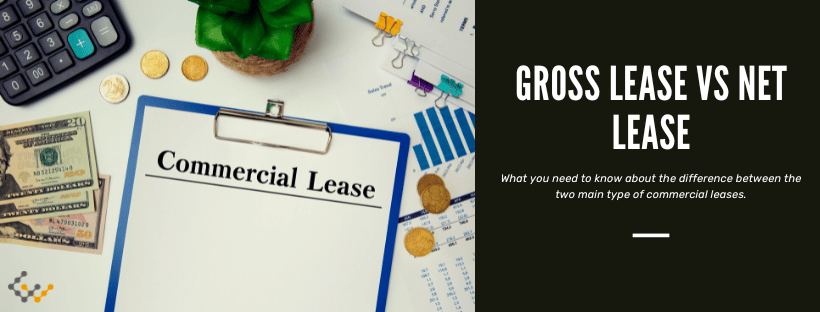Gross Lease vs Net Lease: What’s the Difference?

A variety of commercial leases are available. This helps ensure there is something available to fit any need and most challenges.
There are two main types of commercial leases. The first is a gross lease, and the second is a net lease. It is also sometimes called gross rent vs net rent. The type determines who pays for various expenses associated with the use of the commercial property and how interests are aligned.
What Is a Gross Lease?
A gross lease occurs when the tenant pays a simple, flat fee for having the right to use the space. In this lease, the landlord pays for all expenses that come from the renter’s use of the property. This could include insurance, utilities, taxes, and any necessary repairs.
In this situation, the landlord has to plan for those expenses and build them into the lease and monthly payment.
What Is a Modified Gross Lease?
In a modified gross lease commercial property lease, the tenant will pay a base rent to the property owner. However, the tenant takes on some share of the other expenses and operational costs of the property. This could be utilities, insurance, property taxes, or maintenance. It falls in between the space of a gross lease and a net lease.
What Is a Full Service Gross Lease?
A full service gross lease is another form. In this case, the tenant pays a base rent to the commercial property owner. In addition to this, the landlord pays for all operating expenses that are related to the tenant’s use of the space. This may include maintenance of common areas, utilities, and property taxes.
There is no difference between the term full service gross lease and a gross lease, as they mean the same thing.
Answer a few questions and get custom mortgage quotes. We'll match you with offers from our network of 650+ lenders.
How Does a Gross Lease Work?
In a gross lease, the tenant pays a set amount to the lender each month. This is a single payment made as rent to pay for the user of the property and all included property expenses associated with the property’s use. This is a very common type of lease.
The property owner must determine the rental charge based on all factors that contribute to the cost of managing the property and then factor that into the payment being charged to the tenant.
Pros and Cons of a Gross Lease
There are some good and bad things about a gross lease that commercial property owners should take into consideration before choosing this option for their tenants.
Pros:
- A gross lease may be seen more favorably to the tenant because it is one payment they need to make each month.
- It is easy for the tenant to anticipate the cost of rent on a consistent basis.
Cons:
- If the cost of managing the property increases, such as taxes go up, insurance rates increase, or maintenance costs grow, the property owner or landlord must take the hit for it and pay to cover those costs.
What Is a Net Lease?
A net lease is just the opposite of a gross lease. It is a lease in which the tenant pays more of the actual expenses related to the operation of the property, along with paying a flat fee to the landlord. The tenant may be responsible for paying other expenses, such as repairs, taxes on the real estate, and insurance costs.
Single Net Leases
A single net lease is a type of real estate lease agreement where the tenant pays a portion of the property taxes along with the base rental fee they pay for the property. In this type of lease, which is called a pass through lease, the taxes that are associated with the use of the property are the responsibility of the tenant rather than the landlord.
Double Net Leases
A double net lease occurs when the tenant pays a base rent and then aggress to cover two of the three preliminary additional expenses. This could include property taxes, utilities, or insurance premiums, but not all three. This is also called a net-net lease. It is a very common type of lease agreement used in commercial environments.
Triple Net Leases
In a triple net lease, the property renter will cover the costs of taxes, utilities, and operating costs. In addition to this, the tenant pays the landlord a fee for using the property. The rent under a triple lease will be much lower than that of a single net lease because more of these requirements are excluded.
When it comes to gross lease vs triple net lease, keep in mind that the two are very close to each other, but it is important to understand the specific payments being made may differ from one lease to the next.
Consider the triple net lease vs gross lease. The two may seem simple, but there are differences. Triple net leases and gross leases can cost the same to the property owner. In a triple net lease, the landlord is protected in situations where the property operating costs increase because those expenses are then paid by the tenants directly.
Examples of Net Leases
A net lease could include the following:
- Single net lease: The tenant pays the landlord a set amount each month, along with some of the real estate taxes on the property. The lease value is lower because of that shared risk.
- Double net lease: In this type of lease, the tenant pays a base rental payment to the landlord and then pays, for example, property taxes and insurance premiums on the property.
- Triple leases: In this case, the tenant pays a base amount plus the insurance, real estate taxes, and maintenance.
Pros and Cons of Triple Net Leases
When considering net lease vs gross lease, consider the benefits and disadvantages of triple net leases.
Pros:
- The landlord has the least amount of responsibility in this type of lease.
- These leaders often lead to long term occupancy by the property tenant.
- It creates reliable passive income for the property owner.
Cons:
- There’s limited upside potential in that these are typically long-term loans which leaves little room for upscaling.
- There is a higher turnover risk in some situations, and there could be more difficulty in re-leasing the property.
What is the Main Difference Between Gross Lease and Net Lease?
Knowing the difference between a net and gross rent commercial lease is important. Here’s a look at the main differences:
Gross Lease
A gross lease occurs when the tenant pays a pre-arranged value to the client each month. This covers all costs for that month. The landlord then pays all expenses for the property.
Net Lease
In a net lease, the tenant pays a base amount of money as well as the cost of one or more of the expenses, such as maintenance, property taxes, or insurance premiums.
Gross Lease vs. Net Lease: Which Lease is Right for You?
Consider many factors when it comes to choosing the best lease type. Specifically, ensure that, if choosing a gross lease, the amount charged to the property tenant is enough to cover all expenses related to the ownership of the property and use of it.
A net lease may be an attractive option for landlords, but it tends to be harder to sell to new tenants. It means the landlord takes on less financial risk, though, and may be an important option in securing a long-term lease.
Wrapping Things Up: Gross Lease vs Net Lease
Gross lease vs net lease, also called gross rent vs net rent, is a common question. Commercial property owners may wish to compare both options based on how much the cost of premiums for insurance, real estate taxes, and maintenance costs are likely to grow in the coming year.

